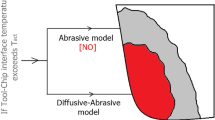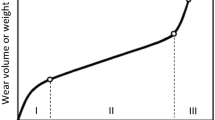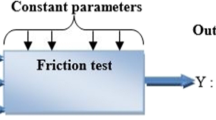Abstract
The aim of this paper is the statistical process control analysis of the tool wear evolution during metal extrusion process for better understanding the principal causes that generate the variability of such a complex phenomenon. The wear prediction is carried out using finite element simulation including the Archard wear model. The tool wear modeling is presented briefly as well as the response surface methodology. The study is based on the application of the central composites designs and allows for the analysis of the response (wear) sensitivity of the tool. The statistical investigation of the process makes it possible to study the influence of each process parameter on the response sensitivity.
Similar content being viewed by others
References
Kragelsky IV, Dobychin MN, Mombalov VS (1982) Friction and wear calculation methods. Pergamon, New York
Hambli R, Badie-Levet D (2000) Damage and fracture simulation during the extrusion process. Comput Meth Appl Mech Eng 186:109–120
Lee GA, Im YT (1999) Finite-Element Investigation of the Wear and Elastic Deformation of Dies in Metal Forming. J Mater Process Technol 89:123–127
Hambli R (2001) Blanking tool wear modeling using the finite element method. Int J Mach Tools Manuf 41(12):1815–1829, September 2001
Montgomery DC (2001) Design and analysis of experiments, 5th edn. Wiley, New York, pp 427–510
Dean A, Voss D (2000) Design and analysis of experiments. Springer, Berlin Heidelberg New York
Benoist D (1994) Plans d’expériences : construction et analyse. Technique & Documentations Lavoisier, Paris, pp 140–147
Archard JF (1953) Contact and rubbing of flat surfaces. J Appl Phys 24:981–988
Carter WT (1994) A model for friction in metal forming. J Eng Mater Technol 113:8–13
Hortig D, Schmoeckel D (1999) Analysis of local loads on the draw die profile with regard to wear using the FEM and experimental investigations. Proceedings of the 7th International Conference on Sheet Metal, Erlangen, Germany, 25–28 September 1999, pp 193–202
Jensen MR, Damborg FF, Nielsen KB, Danckert J (1998) Applying the finite element method for determination of tool wear in conventional deep-drawing. J Mater Process Technol 83:98–105
Kurt L (1985) Handbook of metal forming. McGraw-Hill, Boston
Jensen MR, Damborg FF, Nielsen KB, Danckert J (1998) Applying the finite element method for determination of tool wear in conventional deep-drawing. J Mater Process Technol 83:98–105
Lee GA, Im YT (1999) Finite element investigation of the wear and elastic deformation of dies in metal forming. J Mater Process Technol 89–90:123–127
Hambli R, Potiron A (2000) Finite element modeling of sheet-metal blanking operation with experimental verification. J Mater Process Technol 102:257–265
Paiter B, Shivpuri R, Altan T (1996) Prediction of die wear during hot-extrusion of engine valves. J Mater Process Technol 59:132–143
ABAQUS (2001) ABAQUS/Standard user’s manual, version 6.2. ABAQUS, Providence, RI
Criesfeld MA (1991) Nonlinear finite element analysis of solids and structure, vol 1. Wiley, New York
Marques JMMC (1984) Stress computation in elastoplasticity. Eng Comput 1:43–51
Goupy J (1999) Plans d’expériences pour surfaces de réponse. DUNOD, Paris, pp 253–294
Cornell JA (1990) How to apply response surface methodology. ASQC, Milwaukee, WI
Box GEP, Wilson KB (1951) On the experimental attainment of optimum conditions. J Royal Stat Soc B 13:1–45
Kashiwamura T, Shiratori M, Yu Q (1997) Statistical optimization method. In: Hernandez S, Brebbia CA (eds) Computer aided optimum design of structure V. Computational Mechanics, Billerica, MA, pp 213–227
Lepadatu D, Hambli R, Kobi A, Barreau A (2002) Application des plans dexpériences numériques pour la réduction de l’usure des outils d’extrusion”. Conférence Internationale d’Utilisateurs Francophones d’ABAQUS, Paris, France, 2002
Author information
Authors and Affiliations
Corresponding author
Rights and permissions
About this article
Cite this article
Lepadatu, D., Hambli, R., Kobi, A. et al. Statistical investigation of die wear in metal extrusion processes. Int J Adv Manuf Technol 28, 272–278 (2006). https://doi.org/10.1007/s00170-004-2362-6
Received:
Accepted:
Published:
Issue Date:
DOI: https://doi.org/10.1007/s00170-004-2362-6




